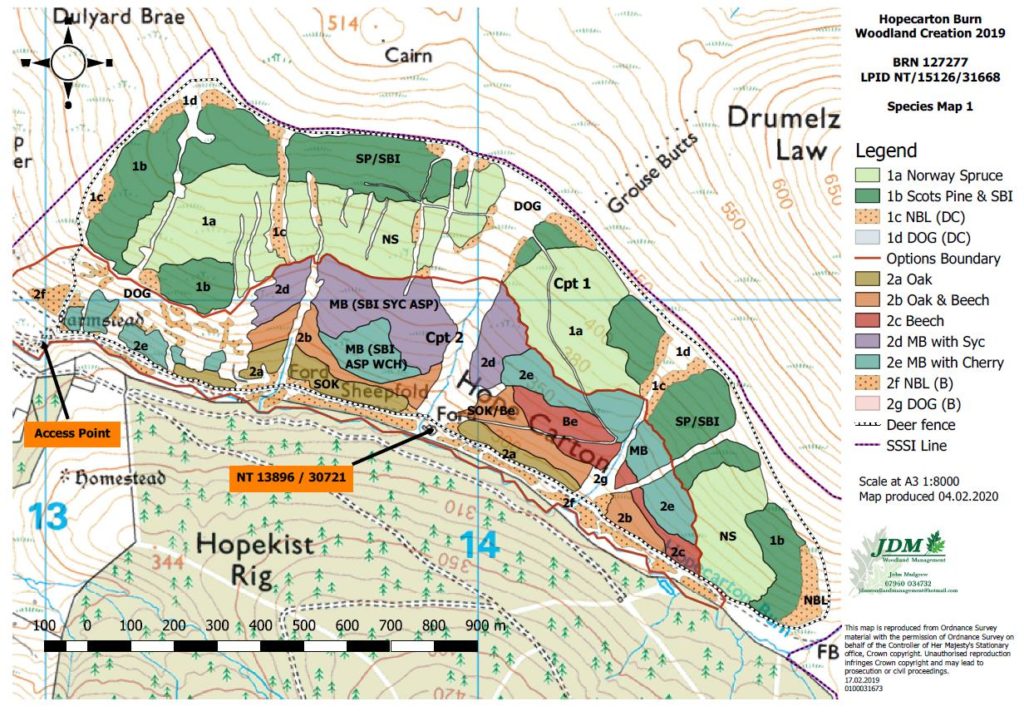The estate owner
Hopecarton Burn, Drumelzier, Scottish Borders
Land use: 101 ha managed for sheep production and, in the past, red grouse
The Challenge:
- Diversify the business for the landowner and his young family – upland sheep farming not as productive as it was
- Create a diverse, colourful and attractive woodland accessible via woodland paths
- Protect important habitats on site and expand existing semi-natural woodland fragments nearby
- Improve local biodiversity including black grouse and golden eagles
- Be considerate of adjacent SSSIs, NSA, SAC and cultural heritage remains on site
- Retain access for sheep to be gathered from further up the glen

How we addressed this:
We secured funding for this scheme through the Forestry Grant Scheme https://forestry.gov.scot/support-regulations/forestry-grants and Woodland Carbon Code https://woodlandcarboncode.org.uk/.
This woodland creation project was in a remote upland location with challenging, steep hill ground. Much of the remaining estate is within a SSSI and watercourses on site flow into the River Tweed SSSI/SAC. A 3 km track upgrade was designed into the scheme, allowing safe access for woodland creation and a future route to extract timber. The design allows sheep farming to continue on the estate, improving access for gathering.
The upper, more exposed ground was suitable for a mix of Scots Pine, Silver Birch and Norway spruce (a ‘diverse conifer’ mix). Lower, more sheltered ground was suitable for a mix of broadleaves native or naturalised to Scotland, comprising Sessile Oak, Silver Birch, Aspen, Wild Cherry and Beech (a ‘productive broadleaves’ mix). Unfortunately, Norway or Field Maple was not available from UK nurseries, so Sycamore was used as a replacement.
Targeted plantings of native broadleaves planted at low density, which will not be felled, included Blackthorn, Downy Birch, Alder, Rowan, Bird Cherry, Wild Cherry, Hawthorn and Aspen around woodland margins and key riparian zones. These trees and shrubs will provide food and cover for important local species such as black grouse, particularly in winter when snow covers the ground. In addition, nearly 1000 Juniper shrubs were planted, which should benefit ring ouzels recorded in the locality.
When designing and planting the woodland, existing flora and fauna, archaeology, public access and views from the local area were taken into consideration.
A combination of woodland management techniques will be used for this site. Productive broadleaves will be managed using a CCF (Continuous Cover Forestry) silvicultural system and conifers using clearfell and restock. The diverse conifer area is divided into 6 windfirm ‘blocks’, which allows the family to decide when each block will be felled to provide a tax-free income. Broadleaves will be thinned, providing further income until a quality hardwood crop is produced over time.
The results:
Over time, this multi-purpose woodland will deliver a range of benefits by;
- Providing an alternative income to sheep farming
- Producing a range of sustainable wood products, providing new tax-free streams to the business
- Protecting and enhancing local biodiversity (flora and fauna) on a large scale
- Sequestering carbon – contributing towards Scotland’s climate change targets
- Improving public access for recreation in the local area
- Improving soil stability on site and water quality in the SSSI/SAC
- Improving the landscape character adjacent to the NSA with attractive, diverse woodlands providing an abundance of autumn colour

